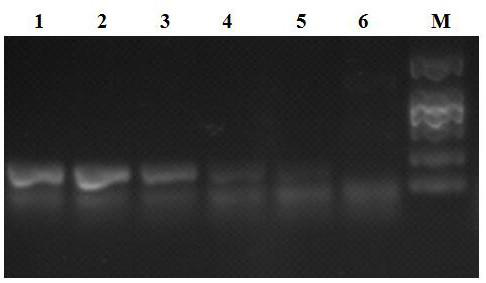Primer combination for detecting 2 soft rot pathogens of orchids, and detection method
A combination of primers and pathogens technology, applied in the direction of microorganism-based methods, biochemical equipment and methods, microorganism measurement/testing, etc., can solve problems such as undiscovered
- Summary
- Abstract
- Description
- Claims
- Application Information
AI Technical Summary
Problems solved by technology
Method used
Image
Examples
Embodiment 1
[0041] like figure 1 As shown, the leaves of Phalaenopsis orchids were inoculated with Erwinia carotovora subsp. Dickia oncidium leaves; healthy Dendrobium leaves as materials.
[0042] DNA extraction:
[0043] Cut 0.5 g of healthy leaves and leaves at the junction of disease and health, respectively, and use CTAB method to extract DNA.
[0044] Primer synthesis:
[0045] Synthesize pathogen-specific primers and Orchidaceae internal reference primers according to Table 1. Primers were synthesized by Beijing Liuhe Huada Gene Technology Co., Ltd.
[0046] The PCR reaction system is 20 μL: 1 μL of DNA template, 1 μL of 10 μmol / L different upstream and downstream primers, 10 μL of 2×TaqPCR Mix reaction solution, add dd H 2 O to a total volume of 20 μL.
[0047]The PCR reaction system was 20 μL; the PCR reaction conditions were: pre-denaturation at 94 °C for 4 min; denaturation at 94 °C for 20 s, annealing at 52-56 °C for 20 s, extension at 72 °C for 30 s, a total of 40 cycl...
Embodiment 2
[0060] Oncidium leaves inoculated with Dikkerella for 24 h
[0061] DNA extraction:
[0062] Cut 0.5 g of leaves at the junction of diseased and healthy leaves, homogenate with 1 mL of sterile water, centrifuge to get the supernatant, and use sterile water to dilute to 1, 10, 100, 1000, 10000, 100000 times dilutions respectively for later use.
[0063] The PCR reaction system is 20 μL: 1 μL of the above diluent template, 10 μmol / L of 1 μL of each of the 3 primers for D. dactyla, 10 μL of 2×Taq PCR Mix reaction solution, add dd H 2 O to a total volume of 20 μL.
[0064] The PCR reaction system was 20 μL; the PCR reaction conditions were: pre-denaturation at 94 °C for 4 min; denaturation at 94 °C for 20 s, annealing at 52-56 °C for 20 s, extension at 72 °C for 30 s, a total of 40 cycles; extension at 72 °C for 6 min.
[0065] 1% agarose electrophoresis to detect 1-6 μL amplification products, such as image 3 As shown, it can be seen that this detection method can detect orc...
Embodiment 3
[0067] Cut and inoculate 0.5 g of leaves at the junction of diseased and healthy leaves with Diektolia and Erwinia carotovora subsp. Figure 4 ), 1mL sterile water homogenate, centrifuge to take the supernatant, and use sterile water to dilute to 1, 10, 100, 1000, 10000, 100000 times dilution respectively for later use.
[0068] The PCR reaction system is 20 μL: 1 μL of the above diluent template, 1 μL of 10 μmol / L different upstream and downstream primers, 10 μL of 2×Taq PCR Mix reaction solution, add dd H 2 O to a total volume of 20 μL.
[0069] The PCR reaction system was 20 μL; the PCR reaction conditions were: pre-denaturation at 94 °C for 4 min; denaturation at 94 °C for 20 s, annealing at 52-56 °C for 20 s, extension at 72 °C for 30 s, a total of 40 cycles; extension at 72 °C for 6 min.
[0070] Figure 5 Among them, the primer combination of different lane reaction tubes is as follows
[0071] Lane 1: Dickeya primers Dickeya F85 and Dickeya R480;
[0072] Lane 2: ...
PUM
| Property | Measurement | Unit |
|---|---|---|
| Sensitivity | aaaaa | aaaaa |
Abstract
Description
Claims
Application Information
 Login to View More
Login to View More - R&D Engineer
- R&D Manager
- IP Professional
- Industry Leading Data Capabilities
- Powerful AI technology
- Patent DNA Extraction
Browse by: Latest US Patents, China's latest patents, Technical Efficacy Thesaurus, Application Domain, Technology Topic, Popular Technical Reports.
© 2024 PatSnap. All rights reserved.Legal|Privacy policy|Modern Slavery Act Transparency Statement|Sitemap|About US| Contact US: help@patsnap.com










